Historical and Political Influences on Nursing Foundations
VerifiedAdded on 2020/02/05
|9
|2127
|399
Essay
AI Summary
This essay explores the historical and political influences on the foundations of professional nursing. It begins by discussing the historical impact of the Sisters of Mercy, highlighting their contributions to the development of "careful nursing" and its ten core principles, which have significantly shaped modern nursing practices. The essay then examines the political influence of Medicare, a national healthcare program, on the healthcare system and nursing professionals. It details how Medicare impacts healthcare access, reduces mortality rates, and promotes clinical research and technological advancements, ultimately benefiting both patients and healthcare providers. The conclusion emphasizes the multifaceted nature of nursing, acknowledging the interplay of historical, political, and socio-economic factors in shaping the profession.
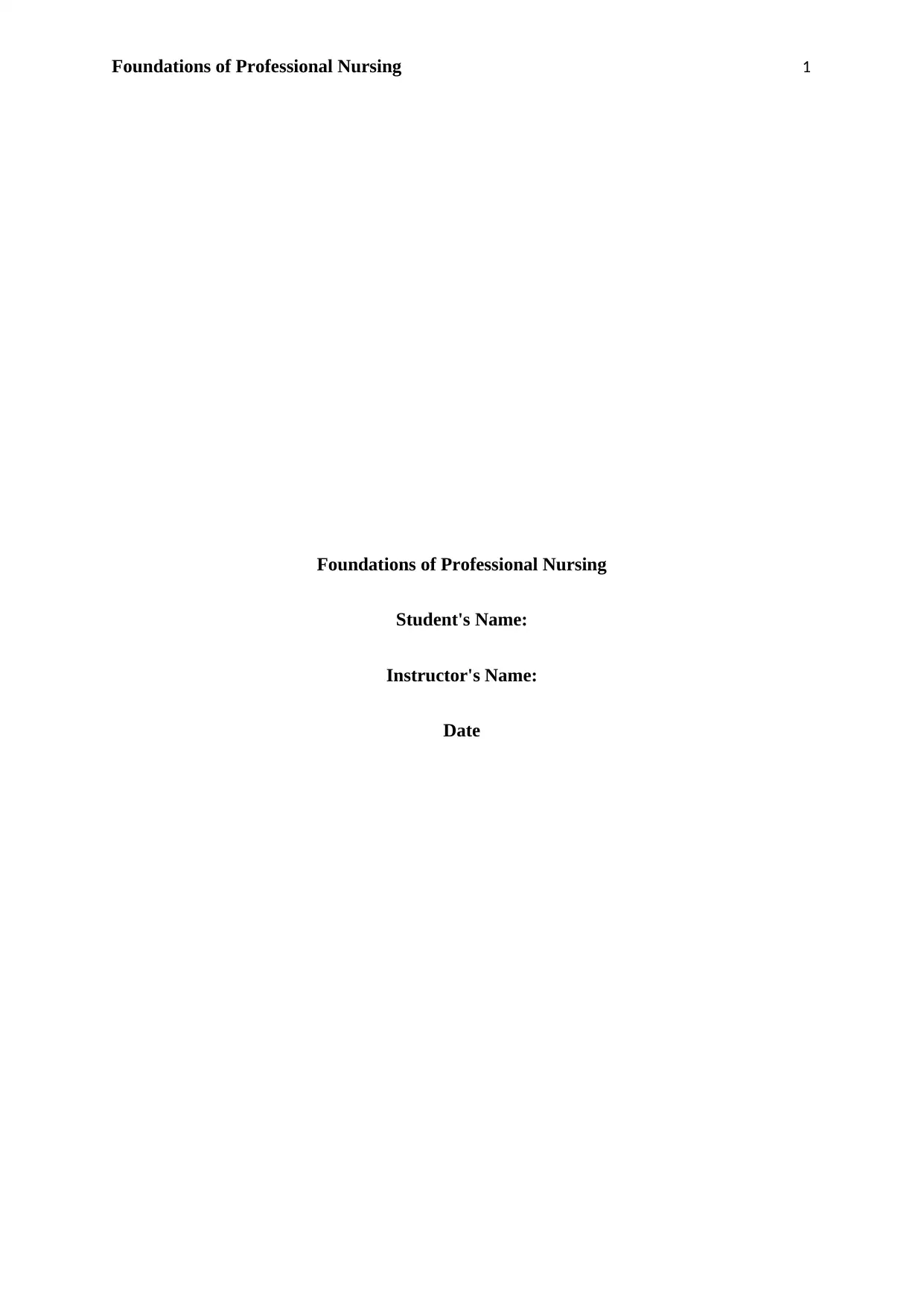
Foundations of Professional Nursing 1
Foundations of Professional Nursing
Student's Name:
Instructor's Name:
Date
Foundations of Professional Nursing
Student's Name:
Instructor's Name:
Date
Paraphrase This Document
Need a fresh take? Get an instant paraphrase of this document with our AI Paraphraser
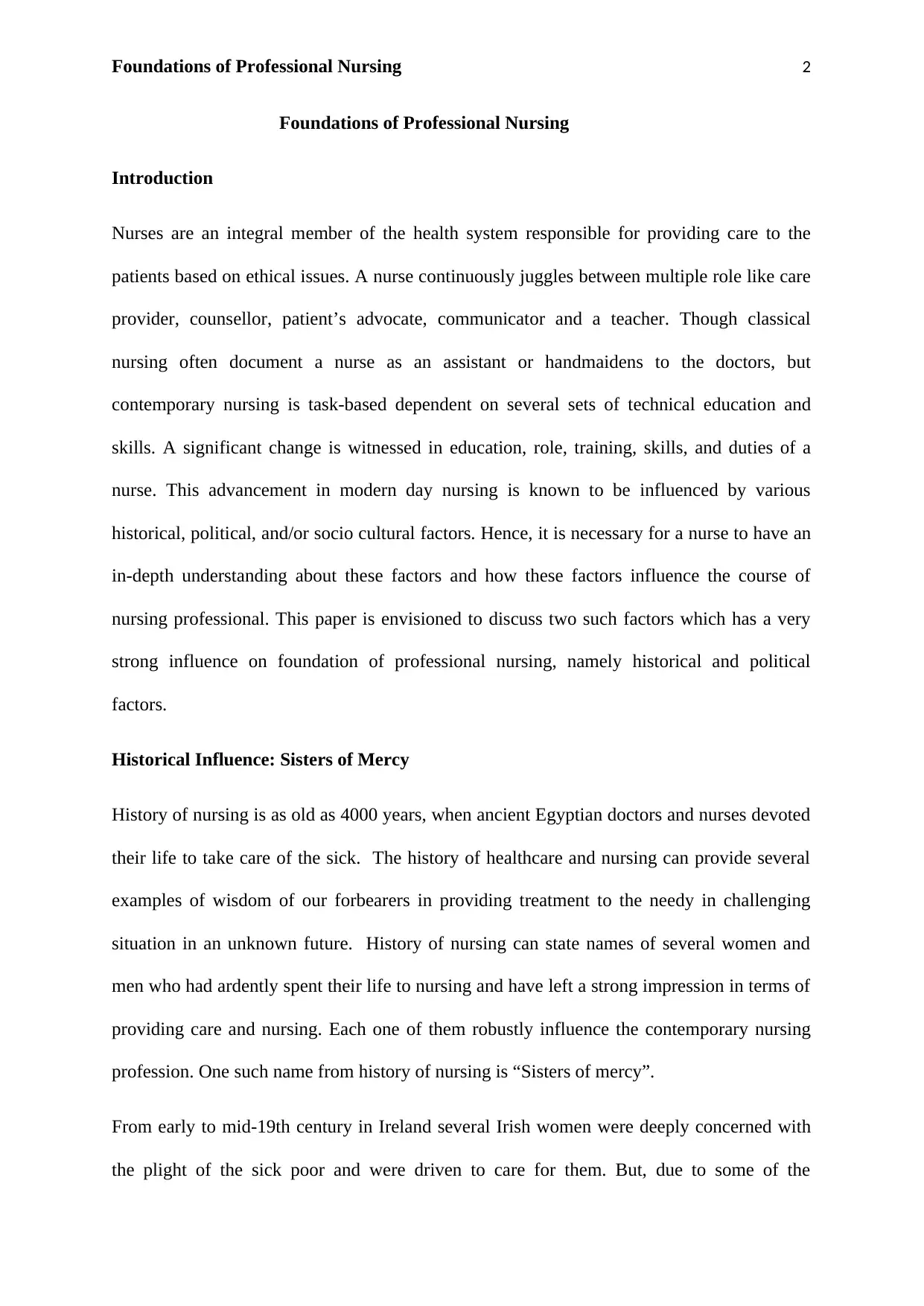
Foundations of Professional Nursing 2
Foundations of Professional Nursing
Introduction
Nurses are an integral member of the health system responsible for providing care to the
patients based on ethical issues. A nurse continuously juggles between multiple role like care
provider, counsellor, patient’s advocate, communicator and a teacher. Though classical
nursing often document a nurse as an assistant or handmaidens to the doctors, but
contemporary nursing is task-based dependent on several sets of technical education and
skills. A significant change is witnessed in education, role, training, skills, and duties of a
nurse. This advancement in modern day nursing is known to be influenced by various
historical, political, and/or socio cultural factors. Hence, it is necessary for a nurse to have an
in-depth understanding about these factors and how these factors influence the course of
nursing professional. This paper is envisioned to discuss two such factors which has a very
strong influence on foundation of professional nursing, namely historical and political
factors.
Historical Influence: Sisters of Mercy
History of nursing is as old as 4000 years, when ancient Egyptian doctors and nurses devoted
their life to take care of the sick. The history of healthcare and nursing can provide several
examples of wisdom of our forbearers in providing treatment to the needy in challenging
situation in an unknown future. History of nursing can state names of several women and
men who had ardently spent their life to nursing and have left a strong impression in terms of
providing care and nursing. Each one of them robustly influence the contemporary nursing
profession. One such name from history of nursing is “Sisters of mercy”.
From early to mid-19th century in Ireland several Irish women were deeply concerned with
the plight of the sick poor and were driven to care for them. But, due to some of the
Foundations of Professional Nursing
Introduction
Nurses are an integral member of the health system responsible for providing care to the
patients based on ethical issues. A nurse continuously juggles between multiple role like care
provider, counsellor, patient’s advocate, communicator and a teacher. Though classical
nursing often document a nurse as an assistant or handmaidens to the doctors, but
contemporary nursing is task-based dependent on several sets of technical education and
skills. A significant change is witnessed in education, role, training, skills, and duties of a
nurse. This advancement in modern day nursing is known to be influenced by various
historical, political, and/or socio cultural factors. Hence, it is necessary for a nurse to have an
in-depth understanding about these factors and how these factors influence the course of
nursing professional. This paper is envisioned to discuss two such factors which has a very
strong influence on foundation of professional nursing, namely historical and political
factors.
Historical Influence: Sisters of Mercy
History of nursing is as old as 4000 years, when ancient Egyptian doctors and nurses devoted
their life to take care of the sick. The history of healthcare and nursing can provide several
examples of wisdom of our forbearers in providing treatment to the needy in challenging
situation in an unknown future. History of nursing can state names of several women and
men who had ardently spent their life to nursing and have left a strong impression in terms of
providing care and nursing. Each one of them robustly influence the contemporary nursing
profession. One such name from history of nursing is “Sisters of mercy”.
From early to mid-19th century in Ireland several Irish women were deeply concerned with
the plight of the sick poor and were driven to care for them. But, due to some of the
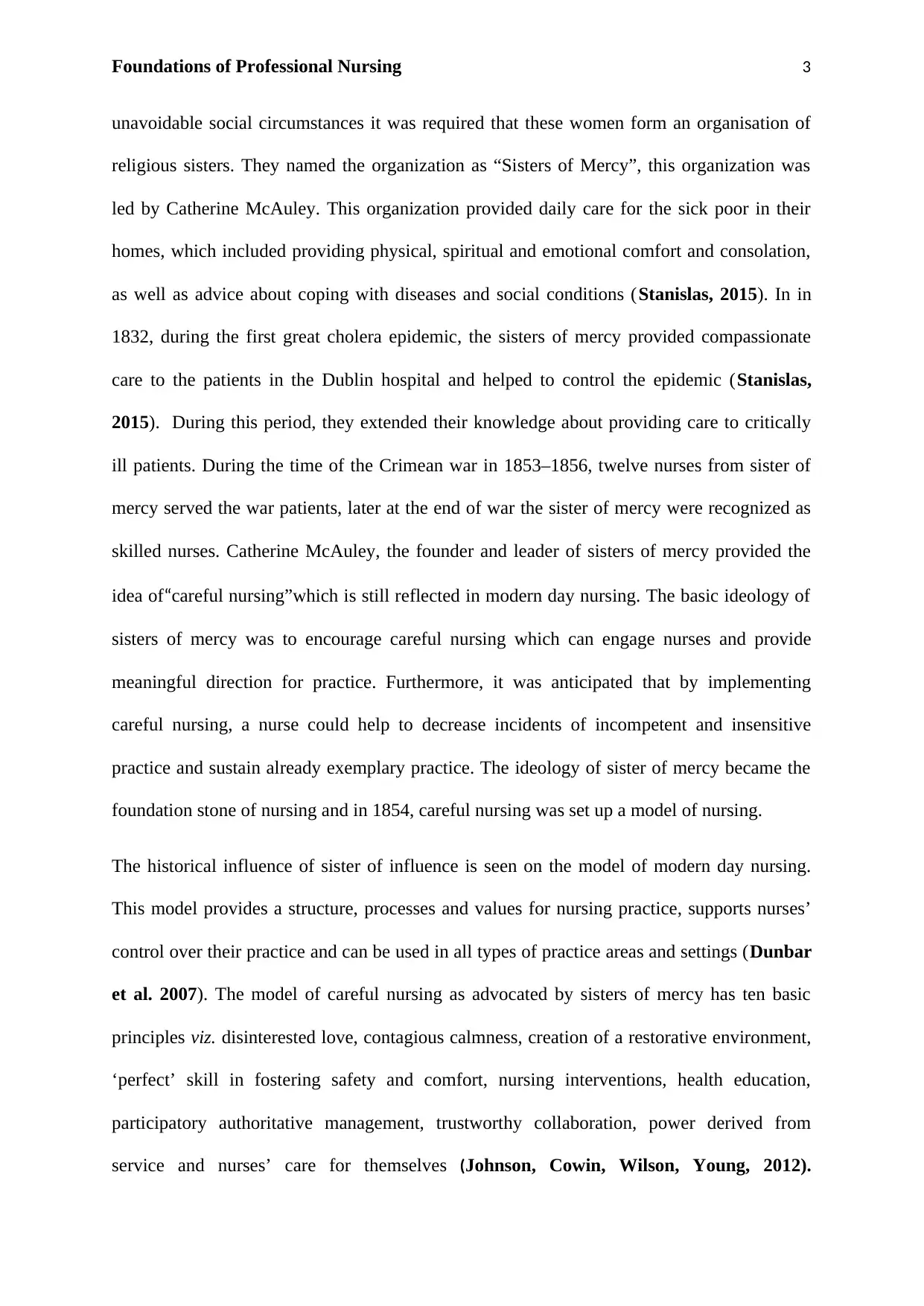
Foundations of Professional Nursing 3
unavoidable social circumstances it was required that these women form an organisation of
religious sisters. They named the organization as “Sisters of Mercy”, this organization was
led by Catherine McAuley. This organization provided daily care for the sick poor in their
homes, which included providing physical, spiritual and emotional comfort and consolation,
as well as advice about coping with diseases and social conditions (Stanislas, 2015). In in
1832, during the first great cholera epidemic, the sisters of mercy provided compassionate
care to the patients in the Dublin hospital and helped to control the epidemic (Stanislas,
2015). During this period, they extended their knowledge about providing care to critically
ill patients. During the time of the Crimean war in 1853–1856, twelve nurses from sister of
mercy served the war patients, later at the end of war the sister of mercy were recognized as
skilled nurses. Catherine McAuley, the founder and leader of sisters of mercy provided the
idea of“careful nursing”which is still reflected in modern day nursing. The basic ideology of
sisters of mercy was to encourage careful nursing which can engage nurses and provide
meaningful direction for practice. Furthermore, it was anticipated that by implementing
careful nursing, a nurse could help to decrease incidents of incompetent and insensitive
practice and sustain already exemplary practice. The ideology of sister of mercy became the
foundation stone of nursing and in 1854, careful nursing was set up a model of nursing.
The historical influence of sister of influence is seen on the model of modern day nursing.
This model provides a structure, processes and values for nursing practice, supports nurses’
control over their practice and can be used in all types of practice areas and settings (Dunbar
et al. 2007). The model of careful nursing as advocated by sisters of mercy has ten basic
principles viz. disinterested love, contagious calmness, creation of a restorative environment,
‘perfect’ skill in fostering safety and comfort, nursing interventions, health education,
participatory authoritative management, trustworthy collaboration, power derived from
service and nurses’ care for themselves (Johnson, Cowin, Wilson, Young, 2012).
unavoidable social circumstances it was required that these women form an organisation of
religious sisters. They named the organization as “Sisters of Mercy”, this organization was
led by Catherine McAuley. This organization provided daily care for the sick poor in their
homes, which included providing physical, spiritual and emotional comfort and consolation,
as well as advice about coping with diseases and social conditions (Stanislas, 2015). In in
1832, during the first great cholera epidemic, the sisters of mercy provided compassionate
care to the patients in the Dublin hospital and helped to control the epidemic (Stanislas,
2015). During this period, they extended their knowledge about providing care to critically
ill patients. During the time of the Crimean war in 1853–1856, twelve nurses from sister of
mercy served the war patients, later at the end of war the sister of mercy were recognized as
skilled nurses. Catherine McAuley, the founder and leader of sisters of mercy provided the
idea of“careful nursing”which is still reflected in modern day nursing. The basic ideology of
sisters of mercy was to encourage careful nursing which can engage nurses and provide
meaningful direction for practice. Furthermore, it was anticipated that by implementing
careful nursing, a nurse could help to decrease incidents of incompetent and insensitive
practice and sustain already exemplary practice. The ideology of sister of mercy became the
foundation stone of nursing and in 1854, careful nursing was set up a model of nursing.
The historical influence of sister of influence is seen on the model of modern day nursing.
This model provides a structure, processes and values for nursing practice, supports nurses’
control over their practice and can be used in all types of practice areas and settings (Dunbar
et al. 2007). The model of careful nursing as advocated by sisters of mercy has ten basic
principles viz. disinterested love, contagious calmness, creation of a restorative environment,
‘perfect’ skill in fostering safety and comfort, nursing interventions, health education,
participatory authoritative management, trustworthy collaboration, power derived from
service and nurses’ care for themselves (Johnson, Cowin, Wilson, Young, 2012).
⊘ This is a preview!⊘
Do you want full access?
Subscribe today to unlock all pages.

Trusted by 1+ million students worldwide
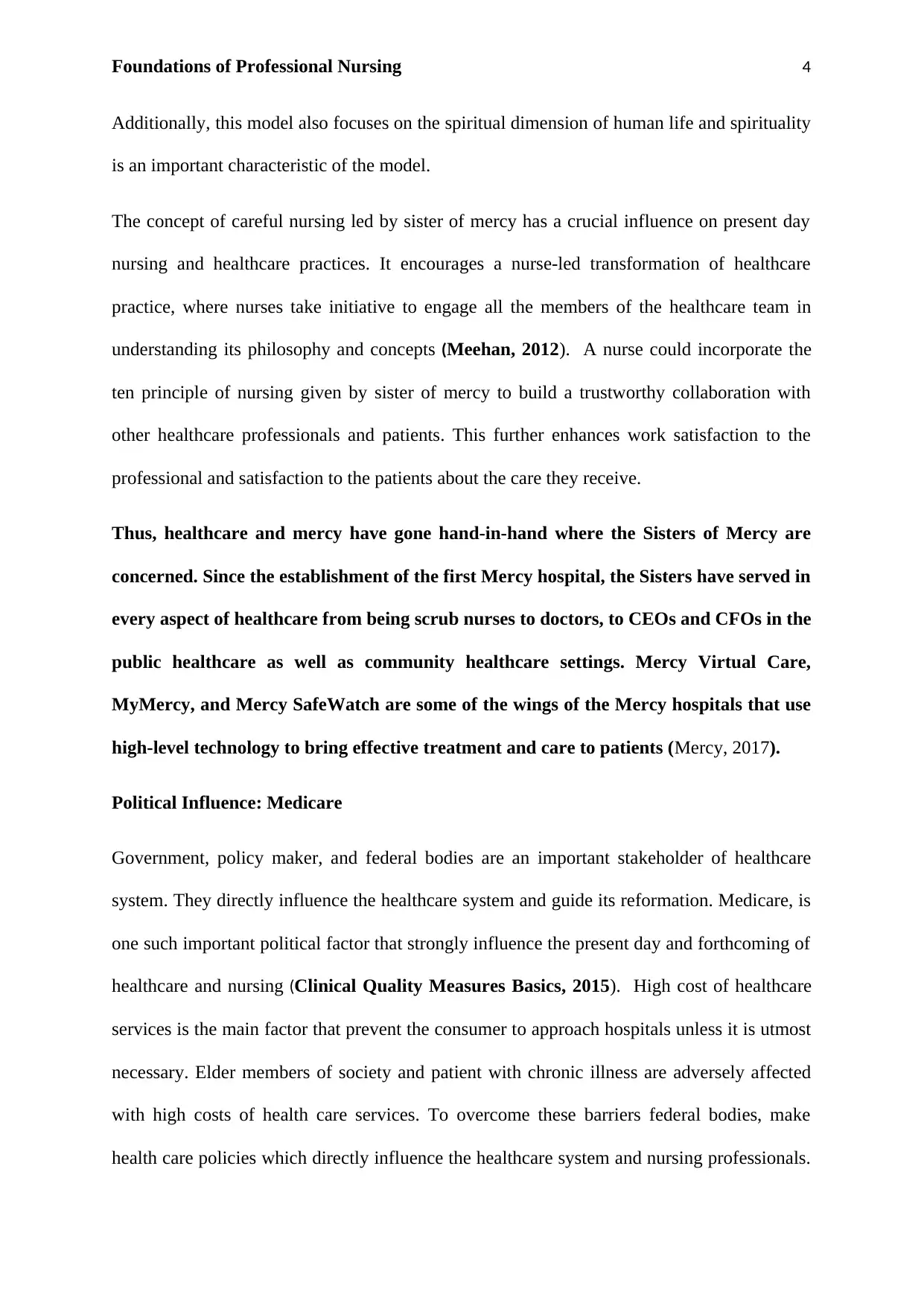
Foundations of Professional Nursing 4
Additionally, this model also focuses on the spiritual dimension of human life and spirituality
is an important characteristic of the model.
The concept of careful nursing led by sister of mercy has a crucial influence on present day
nursing and healthcare practices. It encourages a nurse-led transformation of healthcare
practice, where nurses take initiative to engage all the members of the healthcare team in
understanding its philosophy and concepts (Meehan, 2012). A nurse could incorporate the
ten principle of nursing given by sister of mercy to build a trustworthy collaboration with
other healthcare professionals and patients. This further enhances work satisfaction to the
professional and satisfaction to the patients about the care they receive.
Thus, healthcare and mercy have gone hand-in-hand where the Sisters of Mercy are
concerned. Since the establishment of the first Mercy hospital, the Sisters have served in
every aspect of healthcare from being scrub nurses to doctors, to CEOs and CFOs in the
public healthcare as well as community healthcare settings. Mercy Virtual Care,
MyMercy, and Mercy SafeWatch are some of the wings of the Mercy hospitals that use
high-level technology to bring effective treatment and care to patients (Mercy, 2017).
Political Influence: Medicare
Government, policy maker, and federal bodies are an important stakeholder of healthcare
system. They directly influence the healthcare system and guide its reformation. Medicare, is
one such important political factor that strongly influence the present day and forthcoming of
healthcare and nursing (Clinical Quality Measures Basics, 2015). High cost of healthcare
services is the main factor that prevent the consumer to approach hospitals unless it is utmost
necessary. Elder members of society and patient with chronic illness are adversely affected
with high costs of health care services. To overcome these barriers federal bodies, make
health care policies which directly influence the healthcare system and nursing professionals.
Additionally, this model also focuses on the spiritual dimension of human life and spirituality
is an important characteristic of the model.
The concept of careful nursing led by sister of mercy has a crucial influence on present day
nursing and healthcare practices. It encourages a nurse-led transformation of healthcare
practice, where nurses take initiative to engage all the members of the healthcare team in
understanding its philosophy and concepts (Meehan, 2012). A nurse could incorporate the
ten principle of nursing given by sister of mercy to build a trustworthy collaboration with
other healthcare professionals and patients. This further enhances work satisfaction to the
professional and satisfaction to the patients about the care they receive.
Thus, healthcare and mercy have gone hand-in-hand where the Sisters of Mercy are
concerned. Since the establishment of the first Mercy hospital, the Sisters have served in
every aspect of healthcare from being scrub nurses to doctors, to CEOs and CFOs in the
public healthcare as well as community healthcare settings. Mercy Virtual Care,
MyMercy, and Mercy SafeWatch are some of the wings of the Mercy hospitals that use
high-level technology to bring effective treatment and care to patients (Mercy, 2017).
Political Influence: Medicare
Government, policy maker, and federal bodies are an important stakeholder of healthcare
system. They directly influence the healthcare system and guide its reformation. Medicare, is
one such important political factor that strongly influence the present day and forthcoming of
healthcare and nursing (Clinical Quality Measures Basics, 2015). High cost of healthcare
services is the main factor that prevent the consumer to approach hospitals unless it is utmost
necessary. Elder members of society and patient with chronic illness are adversely affected
with high costs of health care services. To overcome these barriers federal bodies, make
health care policies which directly influence the healthcare system and nursing professionals.
Paraphrase This Document
Need a fresh take? Get an instant paraphrase of this document with our AI Paraphraser
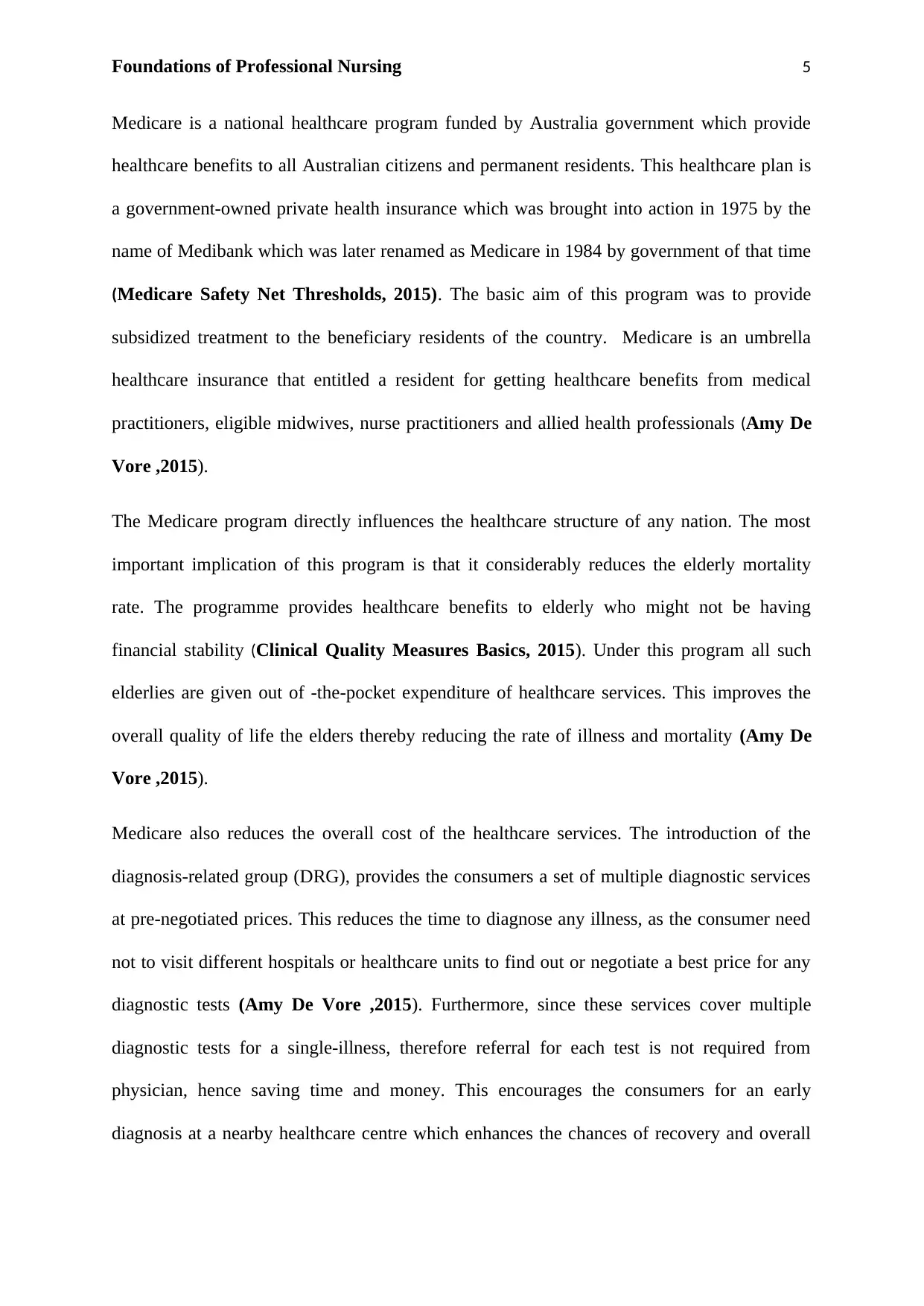
Foundations of Professional Nursing 5
Medicare is a national healthcare program funded by Australia government which provide
healthcare benefits to all Australian citizens and permanent residents. This healthcare plan is
a government-owned private health insurance which was brought into action in 1975 by the
name of Medibank which was later renamed as Medicare in 1984 by government of that time
(Medicare Safety Net Thresholds, 2015). The basic aim of this program was to provide
subsidized treatment to the beneficiary residents of the country. Medicare is an umbrella
healthcare insurance that entitled a resident for getting healthcare benefits from medical
practitioners, eligible midwives, nurse practitioners and allied health professionals (Amy De
Vore ,2015).
The Medicare program directly influences the healthcare structure of any nation. The most
important implication of this program is that it considerably reduces the elderly mortality
rate. The programme provides healthcare benefits to elderly who might not be having
financial stability (Clinical Quality Measures Basics, 2015). Under this program all such
elderlies are given out of -the-pocket expenditure of healthcare services. This improves the
overall quality of life the elders thereby reducing the rate of illness and mortality (Amy De
Vore ,2015).
Medicare also reduces the overall cost of the healthcare services. The introduction of the
diagnosis-related group (DRG), provides the consumers a set of multiple diagnostic services
at pre-negotiated prices. This reduces the time to diagnose any illness, as the consumer need
not to visit different hospitals or healthcare units to find out or negotiate a best price for any
diagnostic tests (Amy De Vore ,2015). Furthermore, since these services cover multiple
diagnostic tests for a single-illness, therefore referral for each test is not required from
physician, hence saving time and money. This encourages the consumers for an early
diagnosis at a nearby healthcare centre which enhances the chances of recovery and overall
Medicare is a national healthcare program funded by Australia government which provide
healthcare benefits to all Australian citizens and permanent residents. This healthcare plan is
a government-owned private health insurance which was brought into action in 1975 by the
name of Medibank which was later renamed as Medicare in 1984 by government of that time
(Medicare Safety Net Thresholds, 2015). The basic aim of this program was to provide
subsidized treatment to the beneficiary residents of the country. Medicare is an umbrella
healthcare insurance that entitled a resident for getting healthcare benefits from medical
practitioners, eligible midwives, nurse practitioners and allied health professionals (Amy De
Vore ,2015).
The Medicare program directly influences the healthcare structure of any nation. The most
important implication of this program is that it considerably reduces the elderly mortality
rate. The programme provides healthcare benefits to elderly who might not be having
financial stability (Clinical Quality Measures Basics, 2015). Under this program all such
elderlies are given out of -the-pocket expenditure of healthcare services. This improves the
overall quality of life the elders thereby reducing the rate of illness and mortality (Amy De
Vore ,2015).
Medicare also reduces the overall cost of the healthcare services. The introduction of the
diagnosis-related group (DRG), provides the consumers a set of multiple diagnostic services
at pre-negotiated prices. This reduces the time to diagnose any illness, as the consumer need
not to visit different hospitals or healthcare units to find out or negotiate a best price for any
diagnostic tests (Amy De Vore ,2015). Furthermore, since these services cover multiple
diagnostic tests for a single-illness, therefore referral for each test is not required from
physician, hence saving time and money. This encourages the consumers for an early
diagnosis at a nearby healthcare centre which enhances the chances of recovery and overall
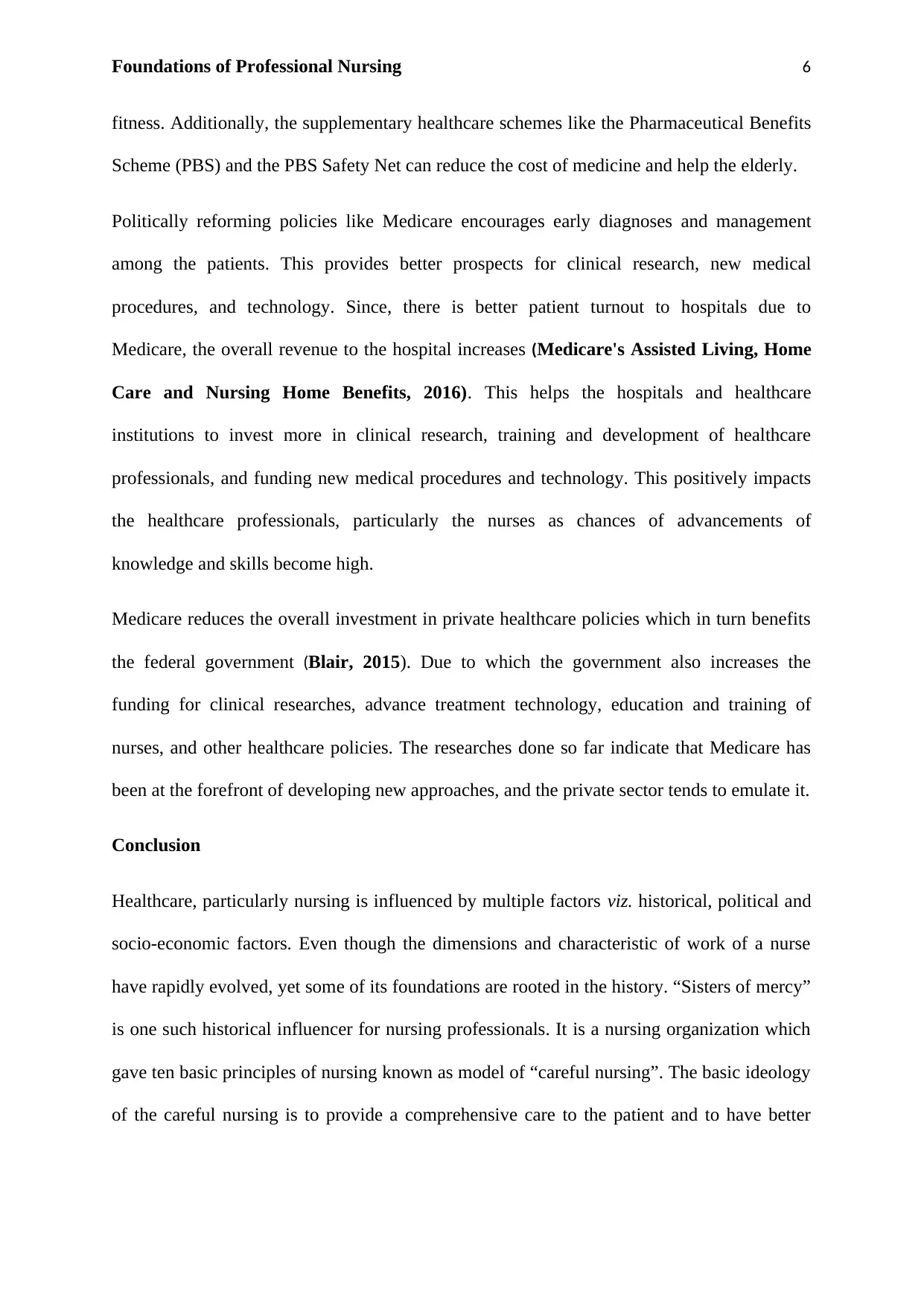
Foundations of Professional Nursing 6
fitness. Additionally, the supplementary healthcare schemes like the Pharmaceutical Benefits
Scheme (PBS) and the PBS Safety Net can reduce the cost of medicine and help the elderly.
Politically reforming policies like Medicare encourages early diagnoses and management
among the patients. This provides better prospects for clinical research, new medical
procedures, and technology. Since, there is better patient turnout to hospitals due to
Medicare, the overall revenue to the hospital increases (Medicare's Assisted Living, Home
Care and Nursing Home Benefits, 2016). This helps the hospitals and healthcare
institutions to invest more in clinical research, training and development of healthcare
professionals, and funding new medical procedures and technology. This positively impacts
the healthcare professionals, particularly the nurses as chances of advancements of
knowledge and skills become high.
Medicare reduces the overall investment in private healthcare policies which in turn benefits
the federal government (Blair, 2015). Due to which the government also increases the
funding for clinical researches, advance treatment technology, education and training of
nurses, and other healthcare policies. The researches done so far indicate that Medicare has
been at the forefront of developing new approaches, and the private sector tends to emulate it.
Conclusion
Healthcare, particularly nursing is influenced by multiple factors viz. historical, political and
socio-economic factors. Even though the dimensions and characteristic of work of a nurse
have rapidly evolved, yet some of its foundations are rooted in the history. “Sisters of mercy”
is one such historical influencer for nursing professionals. It is a nursing organization which
gave ten basic principles of nursing known as model of “careful nursing”. The basic ideology
of the careful nursing is to provide a comprehensive care to the patient and to have better
fitness. Additionally, the supplementary healthcare schemes like the Pharmaceutical Benefits
Scheme (PBS) and the PBS Safety Net can reduce the cost of medicine and help the elderly.
Politically reforming policies like Medicare encourages early diagnoses and management
among the patients. This provides better prospects for clinical research, new medical
procedures, and technology. Since, there is better patient turnout to hospitals due to
Medicare, the overall revenue to the hospital increases (Medicare's Assisted Living, Home
Care and Nursing Home Benefits, 2016). This helps the hospitals and healthcare
institutions to invest more in clinical research, training and development of healthcare
professionals, and funding new medical procedures and technology. This positively impacts
the healthcare professionals, particularly the nurses as chances of advancements of
knowledge and skills become high.
Medicare reduces the overall investment in private healthcare policies which in turn benefits
the federal government (Blair, 2015). Due to which the government also increases the
funding for clinical researches, advance treatment technology, education and training of
nurses, and other healthcare policies. The researches done so far indicate that Medicare has
been at the forefront of developing new approaches, and the private sector tends to emulate it.
Conclusion
Healthcare, particularly nursing is influenced by multiple factors viz. historical, political and
socio-economic factors. Even though the dimensions and characteristic of work of a nurse
have rapidly evolved, yet some of its foundations are rooted in the history. “Sisters of mercy”
is one such historical influencer for nursing professionals. It is a nursing organization which
gave ten basic principles of nursing known as model of “careful nursing”. The basic ideology
of the careful nursing is to provide a comprehensive care to the patient and to have better
⊘ This is a preview!⊘
Do you want full access?
Subscribe today to unlock all pages.

Trusted by 1+ million students worldwide
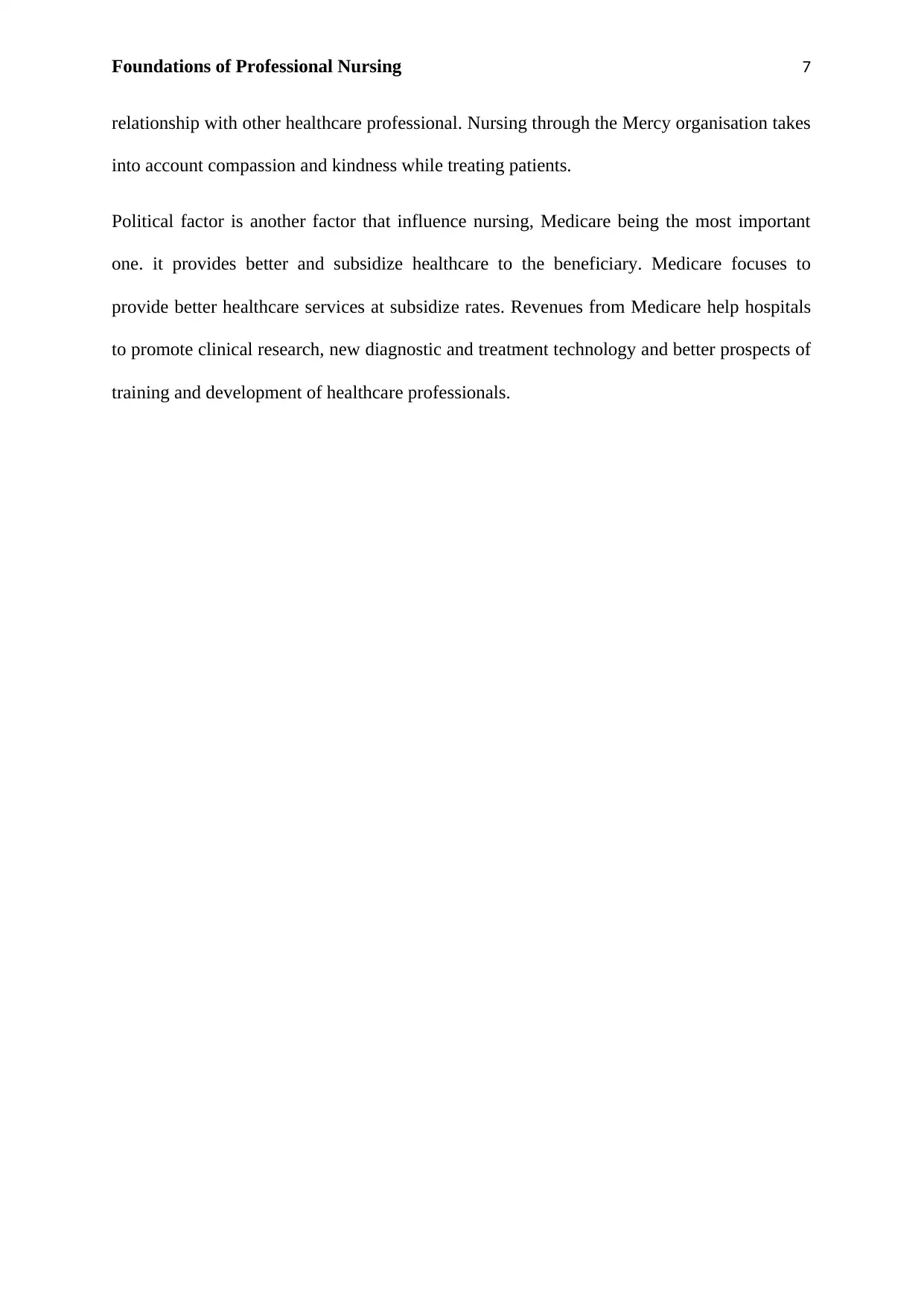
Foundations of Professional Nursing 7
relationship with other healthcare professional. Nursing through the Mercy organisation takes
into account compassion and kindness while treating patients.
Political factor is another factor that influence nursing, Medicare being the most important
one. it provides better and subsidize healthcare to the beneficiary. Medicare focuses to
provide better healthcare services at subsidize rates. Revenues from Medicare help hospitals
to promote clinical research, new diagnostic and treatment technology and better prospects of
training and development of healthcare professionals.
relationship with other healthcare professional. Nursing through the Mercy organisation takes
into account compassion and kindness while treating patients.
Political factor is another factor that influence nursing, Medicare being the most important
one. it provides better and subsidize healthcare to the beneficiary. Medicare focuses to
provide better healthcare services at subsidize rates. Revenues from Medicare help hospitals
to promote clinical research, new diagnostic and treatment technology and better prospects of
training and development of healthcare professionals.
Paraphrase This Document
Need a fresh take? Get an instant paraphrase of this document with our AI Paraphraser
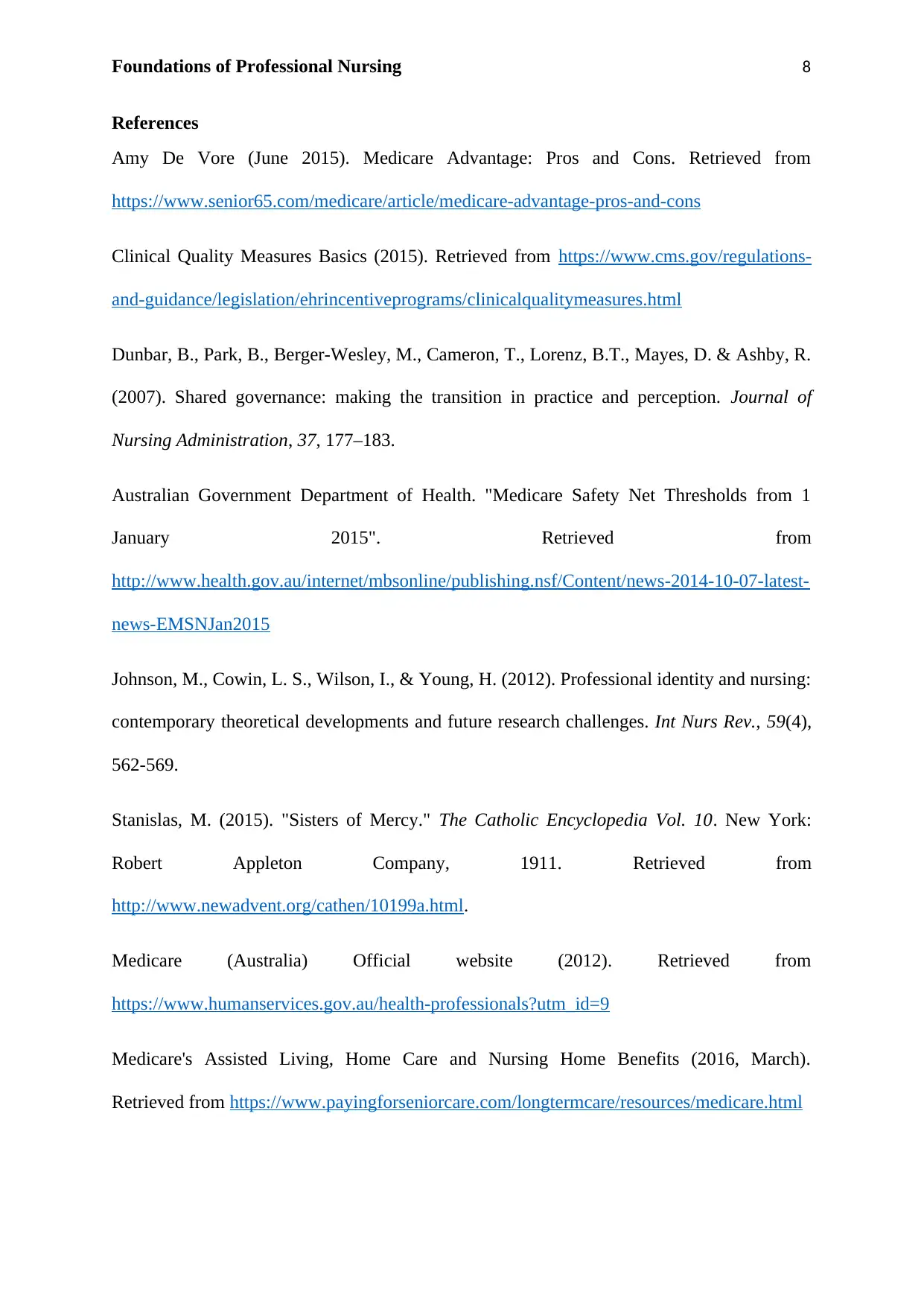
Foundations of Professional Nursing 8
References
Amy De Vore (June 2015). Medicare Advantage: Pros and Cons. Retrieved from
https://www.senior65.com/medicare/article/medicare-advantage-pros-and-cons
Clinical Quality Measures Basics (2015). Retrieved from https://www.cms.gov/regulations-
and-guidance/legislation/ehrincentiveprograms/clinicalqualitymeasures.html
Dunbar, B., Park, B., Berger-Wesley, M., Cameron, T., Lorenz, B.T., Mayes, D. & Ashby, R.
(2007). Shared governance: making the transition in practice and perception. Journal of
Nursing Administration, 37, 177–183.
Australian Government Department of Health. "Medicare Safety Net Thresholds from 1
January 2015". Retrieved from
http://www.health.gov.au/internet/mbsonline/publishing.nsf/Content/news-2014-10-07-latest-
news-EMSNJan2015
Johnson, M., Cowin, L. S., Wilson, I., & Young, H. (2012). Professional identity and nursing:
contemporary theoretical developments and future research challenges. Int Nurs Rev., 59(4),
562-569.
Stanislas, M. (2015). "Sisters of Mercy." The Catholic Encyclopedia Vol. 10. New York:
Robert Appleton Company, 1911. Retrieved from
http://www.newadvent.org/cathen/10199a.html.
Medicare (Australia) Official website (2012). Retrieved from
https://www.humanservices.gov.au/health-professionals?utm_id=9
Medicare's Assisted Living, Home Care and Nursing Home Benefits (2016, March).
Retrieved from https://www.payingforseniorcare.com/longtermcare/resources/medicare.html
References
Amy De Vore (June 2015). Medicare Advantage: Pros and Cons. Retrieved from
https://www.senior65.com/medicare/article/medicare-advantage-pros-and-cons
Clinical Quality Measures Basics (2015). Retrieved from https://www.cms.gov/regulations-
and-guidance/legislation/ehrincentiveprograms/clinicalqualitymeasures.html
Dunbar, B., Park, B., Berger-Wesley, M., Cameron, T., Lorenz, B.T., Mayes, D. & Ashby, R.
(2007). Shared governance: making the transition in practice and perception. Journal of
Nursing Administration, 37, 177–183.
Australian Government Department of Health. "Medicare Safety Net Thresholds from 1
January 2015". Retrieved from
http://www.health.gov.au/internet/mbsonline/publishing.nsf/Content/news-2014-10-07-latest-
news-EMSNJan2015
Johnson, M., Cowin, L. S., Wilson, I., & Young, H. (2012). Professional identity and nursing:
contemporary theoretical developments and future research challenges. Int Nurs Rev., 59(4),
562-569.
Stanislas, M. (2015). "Sisters of Mercy." The Catholic Encyclopedia Vol. 10. New York:
Robert Appleton Company, 1911. Retrieved from
http://www.newadvent.org/cathen/10199a.html.
Medicare (Australia) Official website (2012). Retrieved from
https://www.humanservices.gov.au/health-professionals?utm_id=9
Medicare's Assisted Living, Home Care and Nursing Home Benefits (2016, March).
Retrieved from https://www.payingforseniorcare.com/longtermcare/resources/medicare.html
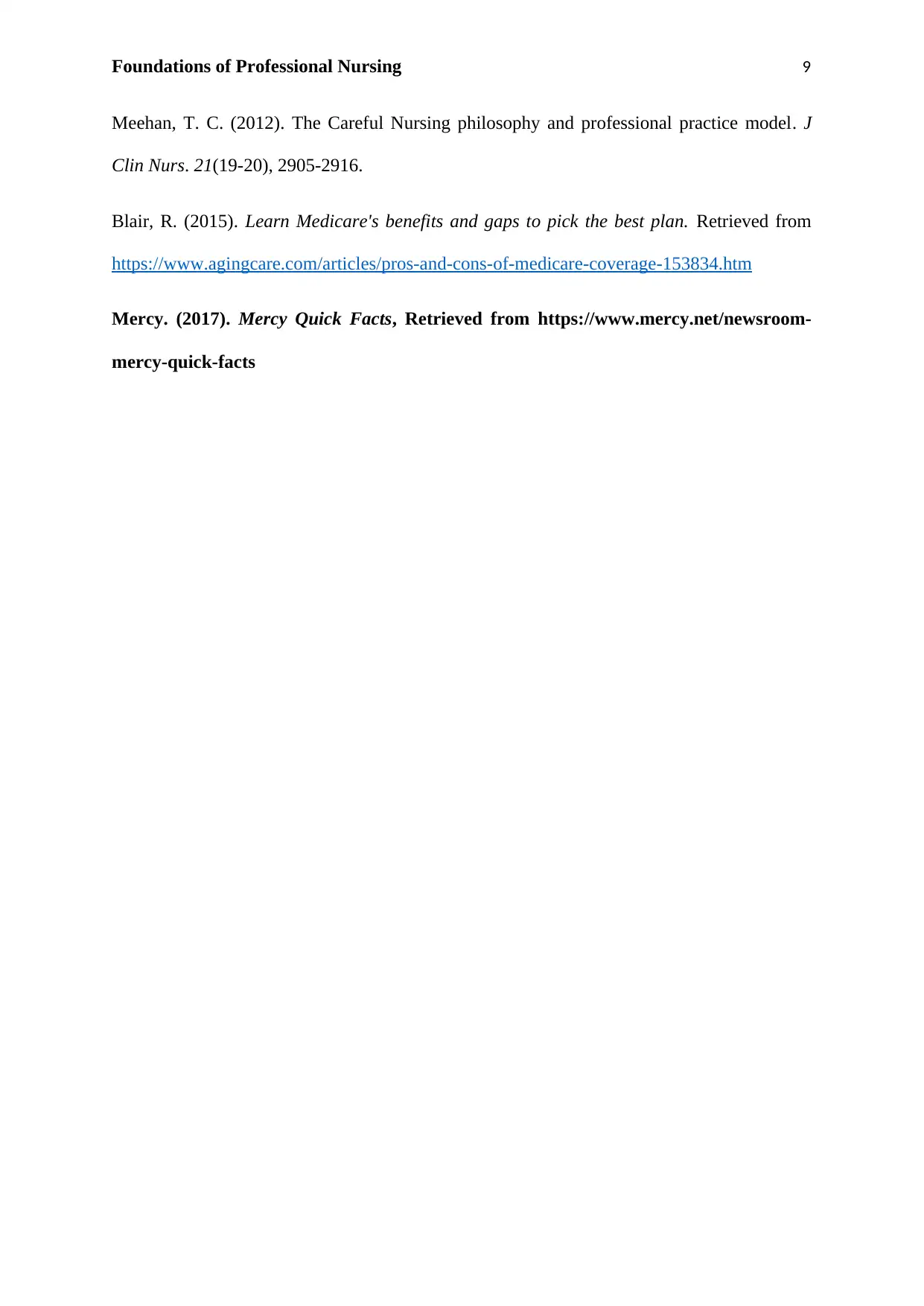
Foundations of Professional Nursing 9
Meehan, T. C. (2012). The Careful Nursing philosophy and professional practice model. J
Clin Nurs. 21(19-20), 2905-2916.
Blair, R. (2015). Learn Medicare's benefits and gaps to pick the best plan. Retrieved from
https://www.agingcare.com/articles/pros-and-cons-of-medicare-coverage-153834.htm
Mercy. (2017). Mercy Quick Facts, Retrieved from https://www.mercy.net/newsroom-
mercy-quick-facts
Meehan, T. C. (2012). The Careful Nursing philosophy and professional practice model. J
Clin Nurs. 21(19-20), 2905-2916.
Blair, R. (2015). Learn Medicare's benefits and gaps to pick the best plan. Retrieved from
https://www.agingcare.com/articles/pros-and-cons-of-medicare-coverage-153834.htm
Mercy. (2017). Mercy Quick Facts, Retrieved from https://www.mercy.net/newsroom-
mercy-quick-facts
⊘ This is a preview!⊘
Do you want full access?
Subscribe today to unlock all pages.

Trusted by 1+ million students worldwide
1 out of 9
Related Documents
Your All-in-One AI-Powered Toolkit for Academic Success.
+13062052269
info@desklib.com
Available 24*7 on WhatsApp / Email
![[object Object]](/_next/static/media/star-bottom.7253800d.svg)
Unlock your academic potential
Copyright © 2020–2025 A2Z Services. All Rights Reserved. Developed and managed by ZUCOL.





